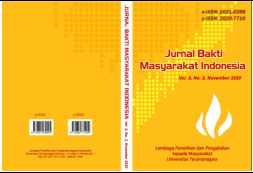PEMBUATAN ALAT BANTU KOMUNIKASI EDUKATIF UNTUK PENYANDANG CEREBRAL PALSY PANTI ASUHAN SAYAP IBU, BINTARO PROTOTYPE: FITTED HEAD POINTING DEVICE
Main Article Content
Abstract
Communication is the main tool for humans to convey information, especially for people with disabilities, communication is very much needed so that they can comunicate Communication will support educational patterns and people with disabilities will be able to get the ideal education. The Banten branch of the Sayap Ibu Foundation has a Special School which is an institution that is engaged in providing education for neglected children with special needs, especially persons with disabilities with Cerebral Palsy conditions. The contribution of product design procurement in designing user-based tools in providing educational communication aids for Cerebral Palsy children at the Sayap Ibu Orphanage is an effort to realize the design of assistive devices for independent educational patterns so that they can type with motor limitations in moving their fingers. Trials and fundamental research in multidisciplinary child development and special education combined in the contribution of tactical design, this design product was developed by the principal, therapist, and the writing team to be realized into a useful design product for Cerebral Palsy children in supporting communication in education they received. With the trial & error method that has been carried out by partners, it is developed with detailed mapping of respondent activities that will be made on a 1: 1 scale for educational communication tools, namely Prototype: Fitted Head Pointing Device. The typing aid that is placed on the head and hands due to the limitations of the respondents in moving their fingers is considered very effective in helping them to type and express their limited forms of communication.
ABSTRAK:
Komunikasi adalah alat dan modal utama untuk manusia dapat menyampaikan informasi, terutama untuk penyandang disabilias komunikasi menjadi sangat dibutuhkan untuk mereka dapat menyampaikan informasi dan mendapatkan informasi. Komunikasi akan menunjang pola edukasi dan penyandang disabilitas akan dapat mendapatkan pendidikan yang ideal. Yayasan Sayap Ibu cabang Banten memiliki Sekolah Sayap Ibu yang merupakan salah satu lembaga yang bergerak di bidang penyelenggaraan pendidikan bagi anak-anak berkebutuhan khusus yang terlantar khususnya penyandang disabilitas dengan kondisi Cerebral Palsy. Kontribusi pengadaan produk desain dalam perancangan alat bantu berbasis pengguna dalam penyediaan alat bantu komunikasi edukatif untuk anak Cerebral Palsy Panti Asuhan Sayap Ibu ini adalah upaya mewujudkan perancangan alat bantu untuk pola edukasi mandiri agar mereka dapat mengetik dengan keterbatasan motorik dalam menggerakan jemari tangan mereka. Uji coba riset mendasar dalam multidisiplin tumbuh kembang anak dan pendidikan khusus dipadu dalam kontribusi desain taktis produk desain ini dikembangkan oleh kepala sekolah, terapis, dan tim penulis untuk dapat di realisasikan menjadi sebuah produk desain yang bermanfaat untuk anak Cerebral Palsy dalam menunjang komunikasi di pendidikan yang mereka terima. Dengan metode uji coba (trial & eror) yang telah di lakukan pihak mitra di kembangkan dengan pemetaan detail aktivitas responden akan dibuat dalam skala 1:1 alat bantu komunikasi edukatif yaitu Prototype: Fitted Head Pointing Device. Alat bantu mengetik yang di letakan di kepala dan tangan karena keterbatasan responden dalam menggerakan jemari ini dianggap sangat efektif untuk membantu mereka dapat mengetik dan mengekspresikan bentuk komunikasi mereka yang terbatas
Article Details
This work is licensed under a Jurnal Bakti Masyarakat Indonesia https://creativecommons.org/licenses/by-nc-sa/4.0/
References
Adelman, H.S. , & Taylor, L. (1985). The future of the LD field. Journal of Learning Disabilities, 18, 422–427.
Galal, G.H. and McDonnel, J.T. “Knowledge-Based Systems in Context: A Methodological Approach to the Qualitative Issues,” AI & Society (11), 1997, pp. 104-121.
Hughes, J. and D, H. “Grounded Theory: Never Knowingly Understood,” Information Systems Review (1), 2000, pp. 181-197.
Orlikowski, W. “CASE tools are organizational change: Investigating Incremental and Radical Changes in Systems Development,” MIS Quarterly, (17:3), 1993, pp. 309-340.
Palisano R, Rosenbaum P, Walter S, Russell D, Wood E, Galuppi B. Development and reliability of a system to classify gross motor function in children with cerebral palsy. Dev Med Child Neurol. 1997;39(4):214–23.
Shamsoddini A, Amirsalari S, Hollisaz MT, Rahimnia A, Khatibi-Aghda A. Management of spasticity in children with cerebral palsy. Iran J Pediatr. 2014;24(4):345-51
Somantri, Sutjihati. (2005). Psikologi Anak Luar Biasa. Bandung: PT Refika Aditama
Sumaatmadja, Nursid. 2002. Pendidikan Pemanusiaan Manusia Manusiawi. Bandung: Alfabeta. 2002: 49
Novak I, Morgan C, Adde L, Blackman J, Boyd RN, Brunstrom-Hernandez J, et al. Early, accurate diagnosis and early intervention in cerebral palsy: Advances in diagnosis and treatment. JAMA Pediatr. 2017;171(9):897–907


